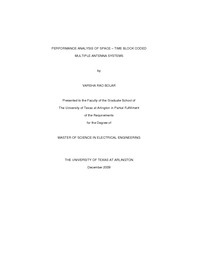
ATTENTION: The works hosted here are being migrated to a new repository that will consolidate resources, improve discoverability, and better show UTA's research impact on the global community. We will update authors as the migration progresses. Please see MavMatrix for more information.
Show simple item record
| dc.contributor.author | Bolar, Varsha Rao | en_US |
| dc.date.accessioned | 2010-03-03T23:30:32Z | |
| dc.date.available | 2010-03-03T23:30:32Z | |
| dc.date.issued | 2010-03-03T23:30:32Z | |
| dc.date.submitted | January 2009 | en_US |
| dc.identifier.other | DISS-10445 | en_US |
| dc.identifier.uri | http://hdl.handle.net/10106/2024 | |
| dc.description.abstract | Multiple input and multiple output(MIMO) communications are seen as key technology to achieve high data rates for next generation of air interfaces like Wifi, WiMAX, and 3GPP-LTE, because of the spatial dimension complementing time (TDM), frequency (FDM), and code (CDM) multiple access technologies. MIMO technology has many captivating characteristics such as, it offers significant increases in data throughput and link range without additional bandwidth or transmit power. It achieves this by higher spectral efficiency (more bits per second per hertz of bandwidth) and diversity (reduced fading). Because of these properties, MIMO is a current theme of international wireless research. Diversity Coding techniques are used when there is no channel knowledge at the transmitter. In diversity methods a single stream is transmitted, but the signal is coded using techniques called space-time coding. The signal is emitted from each of the transmit antennas using certain principles of full or near orthogonal coding. Diversity exploits the independent fading in the multiple antenna links to enhance signal diversity. Considering the evolving nature and wide applications of this technology, it is important to analyze the system performance for different scenarios employing space-time coding, channel coding, interleaving and puncturing.In this thesis, we mainly target the analysis of the bit error rate (BER) performance of the MIMO system with space-time block coding. We have implemented five different configurations of the MIMO system namely, two transmit and one receive antenna, two transmit and two receive antennas, three transmit and one receive antenna, four transmit and one receive antenna and finally four transmit and four receive antenna. We have analyzed the improvement in the performance of the MIMO system over an un-coded system using Rayleigh flat fading channel. Furthermore, we have evaluated the performance of the MIMO system by additionally including channel coding techniques namely convolutional coding and turbo coding which observed that the turbo code provides better reliability than the convolutional codes. Finally, performance analysis is carried out for various interleaving and puncturing schemes in the different MIMO configuration communication systems. | en_US |
| dc.description.sponsorship | Liang, Qilian | en_US |
| dc.language.iso | EN | en_US |
| dc.publisher | Electrical Engineering | en_US |
| dc.title | Performance Analysis Of Space - Time Block Coded Multiple Antenna Systems | en_US |
| dc.type | M.S. | en_US |
| dc.contributor.committeeChair | Liang, Qilian | en_US |
| dc.degree.department | Electrical Engineering | en_US |
| dc.degree.discipline | Electrical Engineering | en_US |
| dc.degree.grantor | University of Texas at Arlington | en_US |
| dc.degree.level | masters | en_US |
| dc.degree.name | M.S. | en_US |
| dc.identifier.externalLink | https://www.uta.edu/ra/real/editprofile.php?onlyview=1&pid=260 | |
| dc.identifier.externalLinkDescription | Link to Research Profiles | |
Files in this item
- Name:
- Bolar_uta_2502M_10445.pdf
- Size:
- 933.1Kb
- Format:
- PDF
This item appears in the following Collection(s)
Show simple item record


